Page 391 of 509

390 Practical hints
What to do if …?
Display Possible cause/consequencePossible solution
Cruise control
- - - mph
(USA only)
You have tried to switch on cruise control
below a speed of 20 mph (30 km/h).�If traffic conditions allow, drive faster than 20 mph (30 km/h)
and save the speed.
Cruise control
- - - km/h
(Canada only)
The automatic transmission* is in position
P, R or N.�Move the gear selector lever to positionD (�page 140).
ESP® is switched off.�Switch on ESP® (�page 64).
The system is overheated.�Wait until the system cools down.
Cruise Control and
Speedtronic
InoperativeCruise control is malfunctioning. In addition
a warning chime sounds.�Have the cruise control checked at an authorized
Mercedes-Benz Center.
Check,
Tire Pressure
Then Restart
Run Flat Indicator
(Canada only)
There was a warning message about a loss
in tire inflation pressure and the Run Flat In-
dicator has not been restarted yet.�Make sure the correct tire inflation pressure is set for each
tire (
�page 339).
�Then restart the Run Flat Indicator (�page 343).
Run Flat
Indicator
Inoperative
(Canada only)
Run Flat Indicator is malfunctioning.�Have the Run Flat Indicator checked at an authorized
Mercedes-Benz Center.
Page 392 of 509
391 Practical hints
What to do if …?
Display Possible cause/consequencePossible solution
Check
Tire Pressure Soon
(Canada only)
The Run Flat Indicator indicates that the
pressure is too low in one or more tires.�Carefully bring the vehicle to a halt, avoiding abrupt steering
and braking maneuvers. Observe the traffic situation around
you.
�Check and adjust the tire inflation pressure as required
(
�page 339).
�If necessary, change the wheel (�page 440).
�Restart the Run Flat Indicator after adjusting the tire inflation
pressure values (
�page 343).
Warning!G
Do not drive with a flat tire. A flat tire affects
the ability to steer or brake the vehicle. You
may lose control of the vehicle. Continued
driving with a flat tire will cause excessive
heat build-up and possibly a fire.
Page 419 of 509
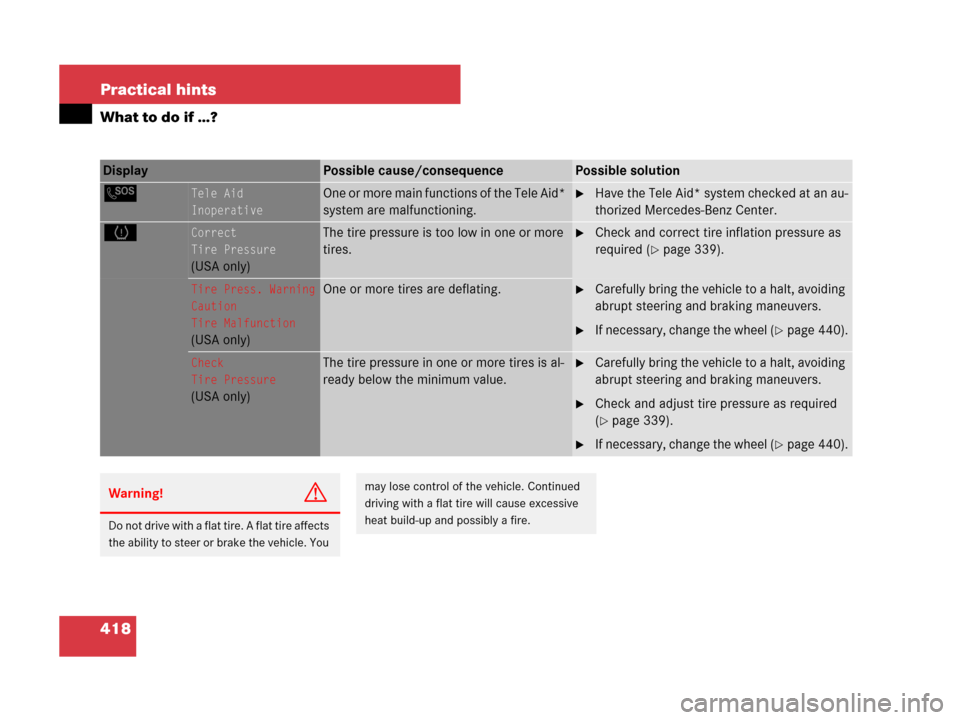
418 Practical hints
What to do if …?
Display Possible cause/consequencePossible solution
LTele Aid
InoperativeOne or more main functions of the Tele Aid*
system are malfunctioning.�Have the Tele Aid* system checked at an au-
thorized Mercedes-Benz Center.
HCorrect
Tire Pressure
(USA only)
The tire pressure is too low in one or more
tires.�Check and correct tire inflation pressure as
required (
�page 339).
Tire Press. Warning
Caution
Tire Malfunction
(USA only)
One or more tires are deflating.�Carefully bring the vehicle to a halt, avoiding
abrupt steering and braking maneuvers.
�If necessary, change the wheel (�page 440).
Check
Tire Pressure
(USA only)
The tire pressure in one or more tires is al-
ready below the minimum value.�Carefully bring the vehicle to a halt, avoiding
abrupt steering and braking maneuvers.
�Check and adjust tire pressure as required
(
�page 339).
�If necessary, change the wheel (�page 440).
Warning!G
Do not drive with a flat tire. A flat tire affects
the ability to steer or brake the vehicle. You
may lose control of the vehicle. Continued
driving with a flat tire will cause excessive
heat build-up and possibly a fire.
Page 441 of 509
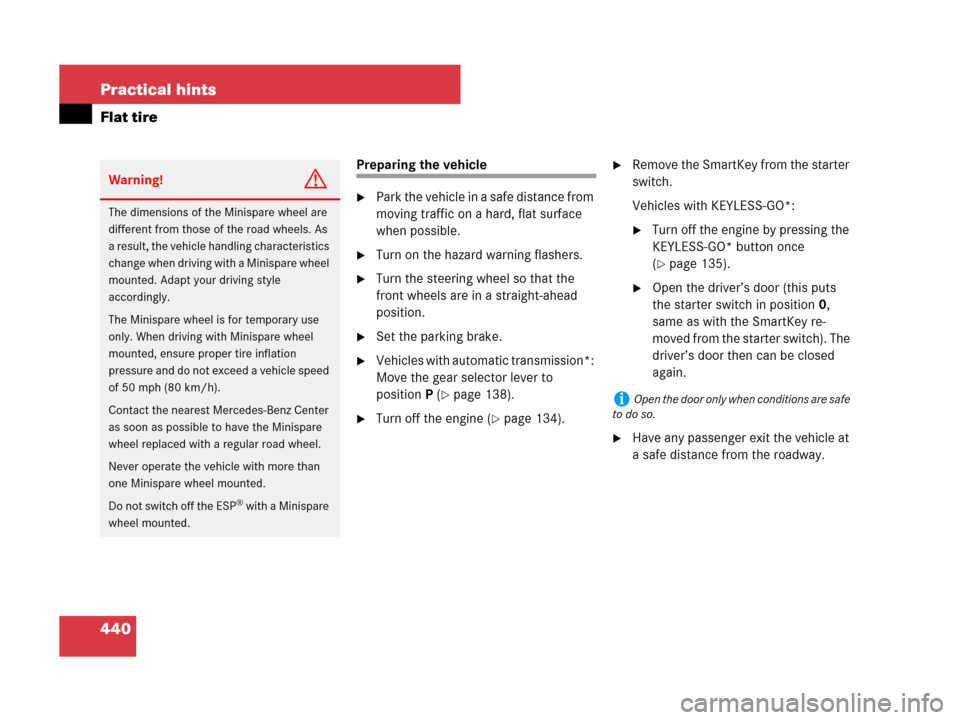
440 Practical hints
Flat tire
Preparing the vehicle
�Park the vehicle in a safe distance from
moving traffic on a hard, flat surface
when possible.
�Turn on the hazard warning flashers.
�Turn the steering wheel so that the
front wheels are in a straight-ahead
position.
�Set the parking brake.
�Vehicles with automatic transmission*:
Move the gear selector lever to
positionP (
�page 138).
�Turn off the engine (�page 134).
�Remove the SmartKey from the starter
switch.
Vehicles with KEYLESS-GO*:
�Turn off the engine by pressing the
KEYLESS-GO* button once
(
�page 135).
�Open the driver’s door (this puts
the starter switch in position0,
same as with the SmartKey re-
moved from the starter switch). The
driver’s door then can be closed
again.
�Have any passenger exit the vehicle at
a safe distance from the roadway.
Warning!G
The dimensions of the Minispare wheel are
different from those of the road wheels. As
a result, the vehicle handling characteristics
change when driving with a Minispare wheel
mounted. Adapt your driving style
accordingly.
The Minispare wheel is for temporary use
only. When driving with Minispare wheel
mounted, ensure proper tire inflation
pressure and do not exceed a vehicle speed
of 50 mph (80 km/h).
Contact the nearest Mercedes-Benz Center
as soon as possible to have the Minispare
wheel replaced with a regular road wheel.
Never operate the vehicle with more than
one Minispare wheel mounted.
Do not switch off the ESP
® with a Minispare
wheel mounted.
iOpen the door only when conditions are safe
to do so.
Page 442 of 509

441 Practical hints
Flat tire
Mounting the Minispare wheel
Preparing the vehicle
�Prepare the vehicle as described
(
�page 440).
�Take vehicle tool kit tray and vehicle
jack out of trunk (
�page 420).
�Take the Minispare wheel from the
wheel well under the trunk floor
(
�page 422).Lifting the vehicle
Warning!G
When jacking up the vehicle, only use the
jack which has been specifically approved
by Mercedes-Benz for your vehicle.
The jack is designed exclusively for jacking
up the vehicle at the jack take-up brackets
built into both sides of the vehicle. Make
sure the jack arm is fully seated in the jack
take-up bracket.
The jack is intended only for lifting the
vehicle briefly for wheel changes. It is not
suited for performing maintenance work
under the vehicle. To help avoid personal
injury, use the jack only to lift the vehicle
during a wheel change.
Never get beneath the vehicle while it is sup-
ported by the jack. Keep hands and feet
away from the area under the lifted vehicle.
Always lower the vehicle onto sufficient
capacity jackstands before working under
the vehicle.
Always firmly set the parking brake and
block wheels with wheel chocks or other
sizeable objects before raising vehicle with
jack. Do not release the parking brake while
the vehicle is raised.
Make sure that the ground on which the
vehicle is standing and where you place the
jack is solid, level and not slippery. If neces-
sary, use a large underlay. On slippery
surfaces, such as tiled floors, you should
use a non-slip underlay, for example a
rubber mat.
Do not use wooden blocks or similar objects
to support the jack. Otherwise the jack may
not be able to achieve its load-bearing
capacity if it is not at its full height.
Be certain that the jack is always vertical
(plumb line) when in use, especially on hills.
Always try to use the jack on level surface.
Never start the engine when the vehicle is
raised.
Also observe the notes on the jack.
Page 443 of 509
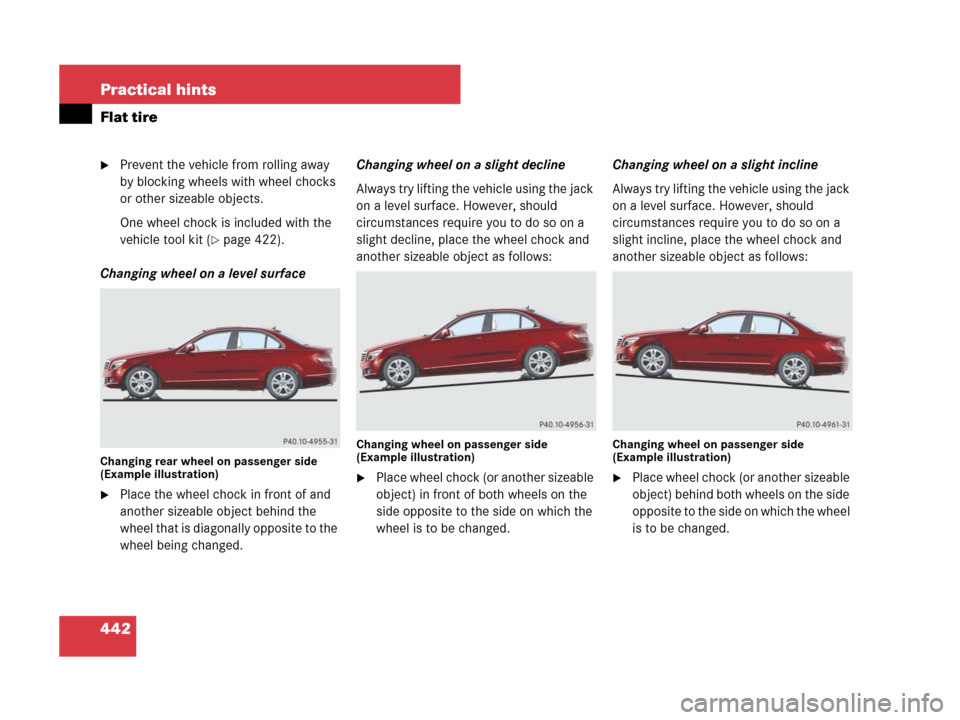
442 Practical hints
Flat tire
�Prevent the vehicle from rolling away
by blocking wheels with wheel chocks
or other sizeable objects.
One wheel chock is included with the
vehicle tool kit (
�page 422).
Changing wheel on a level surface
Changing rear wheel on passenger side
(Example illustration)
�Place the wheel chock in front of and
another sizeable object behind the
wheel that is diagonally opposite to the
wheel being changed.Changing wheel on a slight decline
Always try lifting the vehicle using the jack
on a level surface. However, should
circumstances require you to do so on a
slight decline, place the wheel chock and
another sizeable object as follows:
Changing wheel on passenger side
(Example illustration)
�Place wheel chock (or another sizeable
object) in front of both wheels on the
side opposite to the side on which the
wheel is to be changed.Changing wheel on a slight incline
Always try lifting the vehicle using the jack
on a level surface. However, should
circumstances require you to do so on a
slight incline, place the wheel chock and
another sizeable object as follows:
Changing wheel on passenger side
(Example illustration)
�Place wheel chock (or another sizeable
object) behind both wheels on the side
opposite to the side on which the wheel
is to be changed.
Page 444 of 509
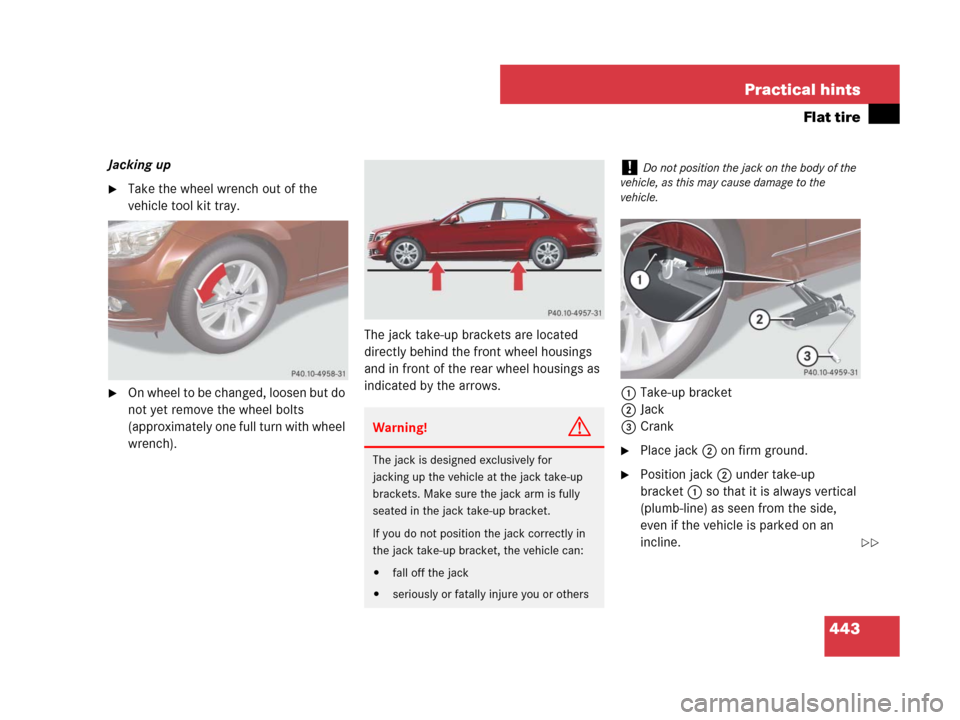
443 Practical hints
Flat tire
Jacking up
�Take the wheel wrench out of the
vehicle tool kit tray.
�On wheel to be changed, loosen but do
not yet remove the wheel bolts
(approximately one full turn with wheel
wrench).The jack take-up brackets are located
directly behind the front wheel housings
and in front of the rear wheel housings as
indicated by the arrows.
1Take-up bracket
2Jack
3Crank
�Place jack2 on firm ground.
�Position jack2 under take-up
bracket1 so that it is always vertical
(plumb-line) as seen from the side,
even if the vehicle is parked on an
incline.
Warning!G
The jack is designed exclusively for
jacking up the vehicle at the jack take-up
brackets. Make sure the jack arm is fully
seated in the jack take-up bracket.
If you do not position the jack correctly in
the jack take-up bracket, the vehicle can:
�fall off the jack
�seriously or fatally injure you or others
!Do not position the jack on the body of the
vehicle, as this may cause damage to the
vehicle.
��
Page 445 of 509
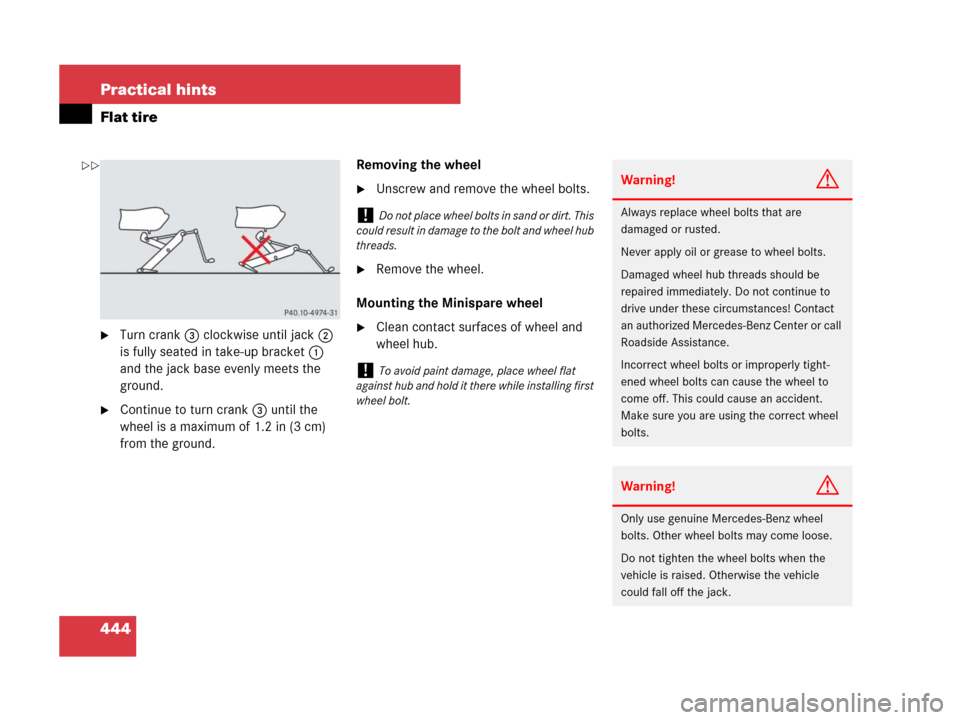
444 Practical hints
Flat tire
�Turn crank3 clockwise until jack 2
is fully seated in take-up bracket1
and the jack base evenly meets the
ground.
�Continue to turn crank 3 until the
wheel is a maximum of 1.2 in (3 cm)
from the ground.Removing the wheel
�Unscrew and remove the wheel bolts.
�Remove the wheel.
Mounting the Minispare wheel
�Clean contact surfaces of wheel and
wheel hub.
!Do not place wheel bolts in sand or dirt. This
could result in damage to the bolt and wheel hub
threads.
!To avoid paint damage, place wheel flat
against hub and hold it there while installing first
wheel bolt.
Warning!G
Always replace wheel bolts that are
damaged or rusted.
Never apply oil or grease to wheel bolts.
Damaged wheel hub threads should be
repaired immediately. Do not continue to
drive under these circumstances! Contact
an authorized Mercedes-Benz Center or call
Roadside Assistance.
Incorrect wheel bolts or improperly tight-
ened wheel bolts can cause the wheel to
come off. This could cause an accident.
Make sure you are using the correct wheel
bolts.
Warning!G
Only use genuine Mercedes-Benz wheel
bolts. Other wheel bolts may come loose.
Do not tighten the wheel bolts when the
vehicle is raised. Otherwise the vehicle
could fall off the jack.
��